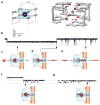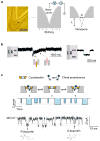Single molecule sensing by nanopores and nanopore devices
- PMID: 20174694
- PMCID: PMC3009472
- DOI: 10.1039/b907735a
Single molecule sensing by nanopores and nanopore devices
Abstract
Molecular-scale pore structures, called nanopores, can be assembled by protein ion channels through genetic engineering or be artificially fabricated on solid substrates using fashion nanotechnology. When target molecules interact with the functionalized lumen of a nanopore, they characteristically block the ion pathway. The resulting conductance changes allow for identification of single molecules and quantification of target species in the mixture. In this review, we first overview nanopore-based sensory techniques that have been created for the detection of myriad biomedical targets, from metal ions, drug compounds, and cellular second messengers to proteins and DNA. Then we introduce our recent discoveries in nanopore single molecule detection: (1) using the protein nanopore to study folding/unfolding of the G-quadruplex aptamer; (2) creating a portable and durable biochip that is integrated with a single-protein pore sensor (this chip is compared with recently developed protein pore sensors based on stabilized bilayers on glass nanopore membranes and droplet interface bilayer); and (3) creating a glass nanopore-terminated probe for single-molecule DNA detection, chiral enantiomer discrimination, and identification of the bioterrorist agent ricin with an aptamer-encoded nanopore.
Figures








Similar articles
-
Aptamer-encoded nanopore for ultrasensitive detection of bioterrorist agent ricin at single-molecule resolution.Annu Int Conf IEEE Eng Med Biol Soc. 2009;2009:6699-702. doi: 10.1109/IEMBS.2009.5333281. Annu Int Conf IEEE Eng Med Biol Soc. 2009. PMID: 19964179 Free PMC article. Review.
-
A Smart Nanopore for Bio-detection.ECS Trans. 2009;16(41):1-8. doi: 10.1149/1.3104704. ECS Trans. 2009. PMID: 30906499 Free PMC article.
-
Single-molecule investigation of G-quadruplex using a nanopore sensor.Methods. 2012 May;57(1):40-6. doi: 10.1016/j.ymeth.2012.03.026. Epub 2012 Apr 2. Methods. 2012. PMID: 22487183 Free PMC article. Review.
-
Capturing single molecules of immunoglobulin and ricin with an aptamer-encoded glass nanopore.Anal Chem. 2009 Aug 15;81(16):6649-55. doi: 10.1021/ac9006705. Anal Chem. 2009. PMID: 19627120 Free PMC article.
-
Method of creating a nanopore-terminated probe for single-molecule enantiomer discrimination.Anal Chem. 2009 Jan 1;81(1):80-6. doi: 10.1021/ac802348r. Anal Chem. 2009. PMID: 19061410 Free PMC article.
Cited by
-
Rational design of DNA nanostructures for single molecule biosensing.Nat Commun. 2020 Sep 1;11(1):4384. doi: 10.1038/s41467-020-18132-1. Nat Commun. 2020. PMID: 32873796 Free PMC article.
-
Designing DNA interstrand lock for locus-specific methylation detection in a nanopore.Sci Rep. 2013 Oct 18;3:2381. doi: 10.1038/srep02381. Sci Rep. 2013. PMID: 24135881 Free PMC article.
-
A Multiplexable Plasmonic Hairpin-DNA Sensor Based On Target-specific Tether Dynamics.ACS Sens. 2021 Dec 24;6(12):4297-4303. doi: 10.1021/acssensors.1c02097. Epub 2021 Dec 1. ACS Sens. 2021. PMID: 34851614 Free PMC article.
-
Single molecule investigation of Ag+ interactions with single cytosine-, methylcytosine- and hydroxymethylcytosine-cytosine mismatches in a nanopore.Sci Rep. 2014 Aug 8;4:5883. doi: 10.1038/srep05883. Sci Rep. 2014. PMID: 25103463 Free PMC article.
-
Enhanced Temporal Resolution with Ion Channel-Functionalized Sensors Using a Conductance-Based Measurement Protocol.Anal Chem. 2017 Jan 17;89(2):1315-1322. doi: 10.1021/acs.analchem.6b04226. Epub 2016 Dec 30. Anal Chem. 2017. PMID: 27981836 Free PMC article.
References
-
-
B. Hille, 2001, 3rd,
-
-
- Bayley H, Cremer PS. Nature. 2001;413:226–230. - PubMed
-
- Song LZ, Hobaugh MR, Shustak C, Cheley S, Bayley H, Gouaux JE. Science. 1996;274:1859–1866. - PubMed
-
- Bayley H, Cremer PS. Nature. 2001;413:226–230. - PubMed
-
- Bayley H, Jayasinghe L. Molecular Membrane Biology. 2004;21:209–220. - PubMed
Publication types
MeSH terms
Substances
Grants and funding
LinkOut - more resources
Full Text Sources
Other Literature Sources

